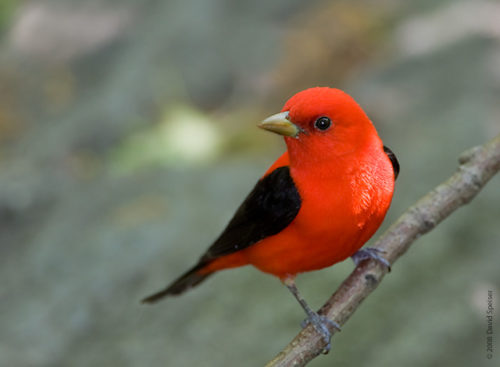It is a relief to write about something beautiful.
 Nothing else looks like a scarlet tanager. This is only the second I have ever seen.
Nothing else looks like a scarlet tanager. This is only the second I have ever seen.
Emerging into a small clearing from deep woods, quiet and slowing to look up, it caught my eye 40 feet high on a broken branch of an ash tree. Scarlet and raven black. It hop-flew from branch to limb to the crown and away.
The male tanager courts his mate by “displaying his scarlet back to [her] overhead.”* He wants her to see the red. Sometimes he will fold his wings down in a cloak to better reveal himself. Look up. Their nests may be 75 feet above your head, “well out on the limbs of oaks, beech, tulip poplar, hemlock or hickory.”* Look up.
They need space. One nesting pair use 4 acres but prefer 8.** They are hard to see. A male with a broken wing kept as a pet lived for 10 1/2 years.*
All around us out there in the brush and grasslands and trees, the birds are living along the periphery of our lives, so look up in deep woods. Stop every few minutes and be still. Look up and wait. Let the birds accommodate themselves to you. They will show themselves in jeweled moments, in breath-held, tunnel-focused seconds — a living creature of a rare encounter will stake you down and remind you of your great good fortune in witnessing a flash of its life.
*The Audubon Society Encyclopedia of North American Birds by John Terres (the indispensable book)
** Birds of Pennsylvania Field Guide by Stan Tekiela.